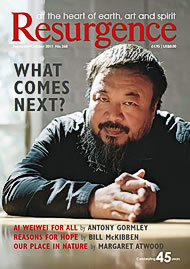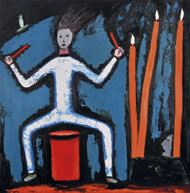At a time when scientific literalism dominates so much of mainstream Western thinking, the very basic human need for the mythic and the sacred is all too often dismissed as the negligible by-product of misfiring chemical connections within the “computer in our head”.
Walk into painter Wynn Jones’s studio in London’s West Hampstead, though, and you will see this is not the case.
What you will witness here is a dynamic cast of riders and racers, singers, sowers and celebrants – all teeming through his huge, fiercely painted and glowingly coloured canvases. That sheer, exhilarating sense of emotional pleasure, together with a subconscious recognition of somehow ‘returning home’ to some long-forgotten world of memory and experience, quickly reminds you of just how much we have, by clinging to materialist assumptions, let slip from the contemporary imagination.
Above all, what we witness in these astonishing paintings is the process by which the artist seeks to construct the mythical framework of his own life; to give it that coherent story by which all the experiences and memories of his experiences to date make both literal and metaphorical sense to him; the measure of their artistic success the degree to which we too can find meanings for ourselves.
That life makes for an interesting story in itself. Wynn Jones was born and brought up in a remote west Wales town in the 1940s. His family home was directly across the road from the chapel, and some of his earliest memories are of the regular, solemn tread of the funeral processions making their way past the house en route to the tree-lined cemetery that overlooked the town. But there was the singing, too, of course. And so it was, as he tells me, “this early and constant awareness of death, allied to the shape-changing legends of traditional Welsh folk-tales, that ensured an encounter with mortality, ritual and myth that remains embedded in my work today”.
As a young man, he found the town a claustrophobic place, its way of life something he yearned to escape at the earliest opportunity, which was provided by art school in Cardiff, followed by a Mellon Foundation Scholarship to the Byam Shaw School of Art in London. What Wynn Jones’s work now reflects is his long, even urgent, journey back into those memories, and their eventual transformation into a poetic and mythical meaning for him: a transformation that has taken some 45 years of his painting life.
In fact, he feels that it is only in the last decade or so that his paintings have come to take on the humanity and fullness of experience that he would expect and hope of them.
As the outpouring of one astonishingly powerful and memorable image after another – Snowblind Singer (2011), Red and Blue Riders (2009), Drummer, Singer & Rider (2010), Red Celebrant (2010) and Passage IV (2009) among them – makes so memorably and eloquently apparent, Wynn Jones has finally begun to find the visual language to realise dreams, memories and stories in paint. And that this should have happened at the precise moment when painting has become such a disparaged (and apparently discredited) medium in contemporary art, dismissed as old-fashioned and unable to bear the weight of meanings attached to it, is a remarkable achievement.
Wynn Jones sees his paintings as having always embodied some sense of a journey and this is apparent even in his much earlier paintings from the late 1970s and early 1980s, when he enjoyed considerable gallery success and critical acclaim before a long ‘dry’ period set in. But it has only been in the last few years or so that the visual language that populates these paintings – the many entrances and passages, pathways and crossings, the “travellings”, as he puts it, “over territories ancient and mysterious”, have come to resolve themselves into any kind of poetic inevitability of form or take on the kind of poetic resonance he would wish for them.
It has, in truth, been an entirely metaphorical journey, the return to this landscape of his childhood having absolutely nothing to do with any idea of nostalgic longing but rather one of imaginative transformation – a ‘stage’, so to speak, for this extraordinary troupe of singers, riders and celebrants who coexist alongside it.
All that said, Wynn Jones’s paintings, with their unexpected mixing of high theatricality and human comedy with unmistakable elements of pathos, tragedy and farce, are not always easy images to come to terms with. They hit you initially with a force you are not accustomed to in much contemporary painting, where emotional evasiveness so often seems to be the preferred option. But, if you start to think, in no particular order, of Dante, Giotto, Watteau, Goya or, in the 20th century, of Philip Guston’s claustrophobic late paintings, Kafka’s sinister, uneasy ‘Laughter in the Dark’ (one of Wynn Jones’s most startling recent paintings is entitled Kafka’s Bucket), or the ‘gallows humour’ of Samuel Beckett’s plays, you begin to get some idea of the particular and unique flavour of these astonishing works.
Wynn Jones himself doesn’t like to discuss the specific subject-matter of individual paintings, feeling that the carefully chosen titles he has given to each have to act as the clues. After that it is up to each viewer to work out what the painting means for him or her. He prefers, instead, to rely on the fact that, as his late painter friend Ken Kiff once advised him, “images that can have meaning for other people can only come from sources deep within oneself. If they come from these sources other people share them.”
There is always this strong sense that, like many of the more substantial of creative figures – poets, composers and writers as well as visual artists among them – this painter is acting as some kind of channel, that the artist is really not quite sure where this imagery comes from, that he is not quite in conscious control of either his jostling repertory of figures or the landscape within which they find themselves.
Perhaps even more important is the way in which this inwardness, or, as he terms it, controlled passion, evokes such a powerful sense not only of the sacred but, at times also, of rather darker forces. Anything more specific you feel this painter to be saying is for us to divine within ourselves. You sense, too, his profound agreement with Kafka’s observation that “the artist is the one who has nothing to say”. Which is another way of saying that true art bears no message, offers no opinion and does not attempt to coerce or persuade, but simply (simply!) bears witness.







